How To Receive Postal Mail & Packages While travelling (Complete Guide)

I think that most of you will agree with me when I say that travelling is awesome.
And, it can be incredibly liberating when it's the type of travel where you decide to completely cut all ties with your native country.
You sell your home and all your personal belongings, close your long-time bank account, cancel all your memberships and subscriptions and hit the road for an indefinite length of time.
But not everybody wants or needs to burn all their bridges like that when they travel.
When most of you go abroad you're not packing up and renouncing your homeland forever, but just temporarily leaving it behind to discover what other parts of the world have to offer.
Shutting down your entire life only to have to reboot it again from scratch upon your return would make little sense.
Thus while on the road, you will probably want to maintain connections and relationships with certain service providers, insurance companies, banks, clubs, organizations, government bodies and individuals back home.
Preserving some of these relationships while you travel may even be of critical importance to prevent things from falling apart back home or to maintain access to your bank account.
Luckily, with the availability of electronic communication methods in today's world, corresponding with all of these entities back home while you're travelling should be a piece of cake.... except that often it's not.
The issue is that many companies and institutions may still insist on corresponding with you via the old-fashioned system of snail mail.
So while you’re off travelling in far-flung lands, letters, postcards, bank statements, utility bills, verification codes, cheques, tax forms, ballot forms, and other mail items will probably keep inundating your mailbox back home.
Of course, when you go away on a short holiday or vacation, you’re probably happy enough to let a few envelopes pile up in your mailbox or porch (or maybe you have a trusted neighbour collect the mail for you) until you return home and get a chance to go through everything.
But if you’re planning to disappear for several months or even a few years, it’s hardly feasible to let the task of managing your mail wait until you get home. Some of those letters could have critical information.
Another issue if you're going off on an extended trip is that you may not even have a physical street address to receive mail at anymore.
You're probably no longer renting a place or may have sold your home to fund your trip and you may not have any friends or family to handle your mail for you on your behalf.
So, the first problem that most travellers need to solve is that of receiving, viewing and managing their postal mail remotely.
And then what if you need to have certain mail items physically forwarded or directly delivered to you while you're travelling?
Remember that most bank cards, health insurance cards and driving licenses have an expiry date and you might have to renew or replace them while you're on the road.
On longer trips you’ll also inevitably need or wish to order new travel gear, electronics, clothing and other items from online retailers like Amazon, Lazada and eBay at some point.
After all, clothing and travel gear eventually wears out, breaks down, becomes outdated and can get damaged, lost or stolen.
And when you do have to replace important gear it’s often a lot easier to find the item you’re looking for online, and so you then need to figure out a way to receive the shipment of your item from the retailer.
So the second problem you need to know how to solve, especially if you're taking an extended trip, is how to receive packages when you're travelling.
.jpg)
Unfortunately, receiving packages can be rather tricky when you’re a moving target and your address keeps changing every couple of days, but don't worry because in this article we've got you covered.
We've broken down the article into two parts; in part 1 we cover the solutions for the problem of managing your postal mail remotely and in part 2 we look at a few strategies for receiving packages while on the move.
Let’s get right into it.
Part 1: How to receive and manage your regular postal mail while travelling
As it turns out, remotely receiving letters and other kinds of paper correspondence that comes in the mail is actually easier than receiving packages.
This is because most of the mail that you receive just consists of information, which can be transmitted to you electronically without you having to receive the original, physical copy.
You can be just as well informed by reading a digital PDF scan or JPEG photo of a paper document as by reading the original document.
Several companies have taken this concept and used it to create a comprehensive mail management solution for travellers, but before we discuss these services, we want to briefly discuss physical P.O boxes - an old school solution that might still work for some people.
Solution 1: The physical P.O Box
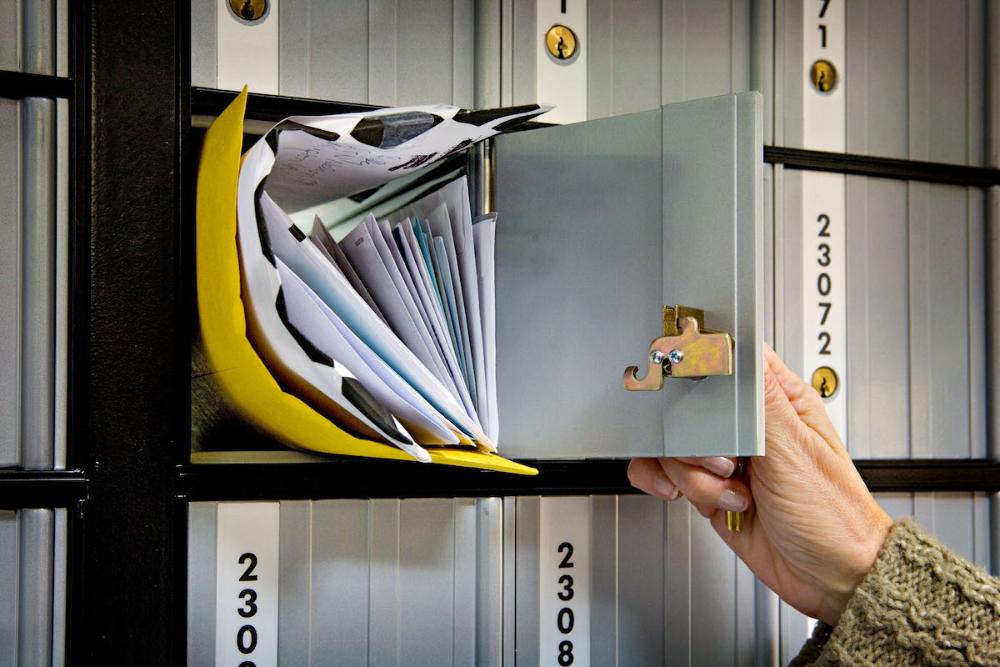
A P.O box or post office box is a secure, lockable mailbox located inside a post office that you can rent out (for a fee) and use to receive some or all of your incoming mail.
Some people use P.O boxes to protect their privacy (you might not want certain companies or organizations to know your home address), to receive mail faster (since you don’t have to wait for the postman) or to receive mail when living in a remote location that mail can’t be directly delivered to.
But a P.O box is also rather useful if you travel, since it gives you a stable address that you can have all your mail sent to while abroad.
A P.O box could be very handy if you’re a traveller who doesn’t currently own a home and you don’t want to be burdening friends or relatives with all your postal mail while you’re away.
Having a P.O box to direct mail to also reduces the risk of identify theft, because it means that mail containing sensitive information won’t accidentally get sent to an old address that you owned or rented before you decided to travel.
P.O boxes are available in many countries around the world. In the United States for example, they’re provided by the USPS (United States Postal Service) and you can choose a P.O box from around 49 post offices nationwide.
One limitation with a P.O box is that all it does is hold your mail securely until you get home. Of course, this is better than an unlocked mailbox or the front porch of your house (which is more vulnerable to thieves), but not a whole lot better.
The problem is that you can’t inspect the mail until you return home and visit the post office, and some of the information in that mail could be crucially important.
Technically, you can have mail forwarded from many P.O boxes, but will cost you a pretty penny, and it would hardly seem worth the money just to receive "information", which is so easy to transmit electronically these days.
Also, the post office will usually bulk forward all your mail, including the junk mail that you don't even want to receive.
Another problem with a P.O box is that it could start overflowing with mail before you return home and have a chance to empty it out, and you will be asked to upgrade to a larger box.
But then the problem is that the larger P.O boxes with more mail-holding capacity can be significantly more expensive than the smaller ones.
Another major issue with P.O boxes is that although the larger boxes are designed to hold parcels, many online retailers will not ship to P.O boxes and will demand that you provide a physical street address.
This is because courier companies will not deliver to a P.O box since there is nobody to accept and sign for the package.
The final drawback with P.O boxes is that they don’t present a very professional image.
If you’re doing business while abroad and you’re having all your business-related correspondence sent to a P.O box, the fact that you don't possess a physical street address could hurt your company's credibility.
And if you're trying to set up a LLC company or corporation, a P.O box address is not accepted as your commercial business address.
The cost of a P.O box can vary a lot depending on the country, the physical location of the box, the dimensions of the box and the length of time it will be rented for.
Just to give an example, at the time of writing, an XS (extra small) USPS P.O box that holds just 10 – 15 letters would cost you $58 for a 6-month rental period, and an XL (extra large) P.O box suitable for packages and flat rate boxes would cost you $513 for the same.
Generally you can apply for a P.O box online or by calling into the post office and you’ll probably need to provide one or more forms of ID.
The bottom line: A P.O box could provide a workable solution for you if you’re not going to be away for too long, you receive low volumes of mail, most of your incoming mail is junk or non-priority, and you don’t need to present a professional image to businesses.
If that doesn't sound like you, see the next solution below.
Solution 2: Get a virtual mailbox

Also known as an online mailbox or online P.O box, a virtual mailbox is the best solution if you're taking an extended trip, if you receive high volumes of postal mail or if you wish to have immediate access to your mail when it arrives.
It’s also the best solution if you need a physical street address for your business in order to portray a professional image.
A virtual mailbox works a bit like a physical P.O box except that:
- It’s managed by a private company rather than a public post office and this company can actually receive and manage packages and mail on your behalf
- You can opt to have a physical street address that will be valid for receiving packages from online retailers and will present a more professional image
- It gives you immediate access to any postal mail that arrives for you, because one of the things it can do is digitize all your mail so that you can view it online from anywhere in the world.
- You have a lot more options for what to do with your mail once it arrives
Once mail is delivered to your virtual mailbox, you’ll usually be notified by email and you’ll be able to log into your online account and view scanned images of the outsides of any packages or envelopes that arrived for you, so that you can decide what actions to take next.
From here you can usually instruct your virtual mailbox provider to perform any of the following actions:
- Open the mail and scan the contents for easy viewing online
- Forward selected letters or packages to another address
- Return mail or packages to the sender
- Deposit physical cheques into your bank account
- Physically archive the mail until further notice or until you arrive to pick it up (physical storage is often free for the first 30 days)
- Shred or recycle the mail
With most providers you purchase plans that allow for a limited number of letters, packages, opens and scans per month, but you can always pay extra if you need to exceed these limits, or upgrade to a more expensive plan.
Another thing you need to know about virtual mailboxes is that to sign up you’ll normally have to undergo an identity verification process where you’ll need to prove your identity and address.
If you’re a U.S citizen, you may need to submit a notarized USPS 1583 form to the virtual mailbox provider, which essentially gives the company permission to receive and handle your mail.
Getting this form notarized while overseas could be bit tricky so if you’d like a more convenient way to get the job done, there is an online notary service called NotaryCam.
NotaryCam lets you instantly e-notarize any document from the convenience of your computer.
All you have to do is upload the document on the company’s website and then you’ll be connected face-to-face with a live, certified U.S notary on webcam.
You then just electronically sign your document and after the notary confirms your identity they’ll apply their e-notary seal, which means the document is now legally notarized in all 50 U.S states.
The e-notarized document will then be instantly e-mailed to both you and the virtual mailbox provider.
The price per signature for U.S customers is pretty reasonable at $25, although the company bumps it up to $79 per signature for international customers.
The best virtual mailbox providers for travellers
So now that you have an idea about how virtual mailbox services operate, you must surely be wondering what are the top virtual mailbox providers out there?
Luckily for you, we’ve done our homework and rounded up three of the most reputable and well-known providers in the industry.
Here are five of our recommendations.
1. Traveling Mailbox
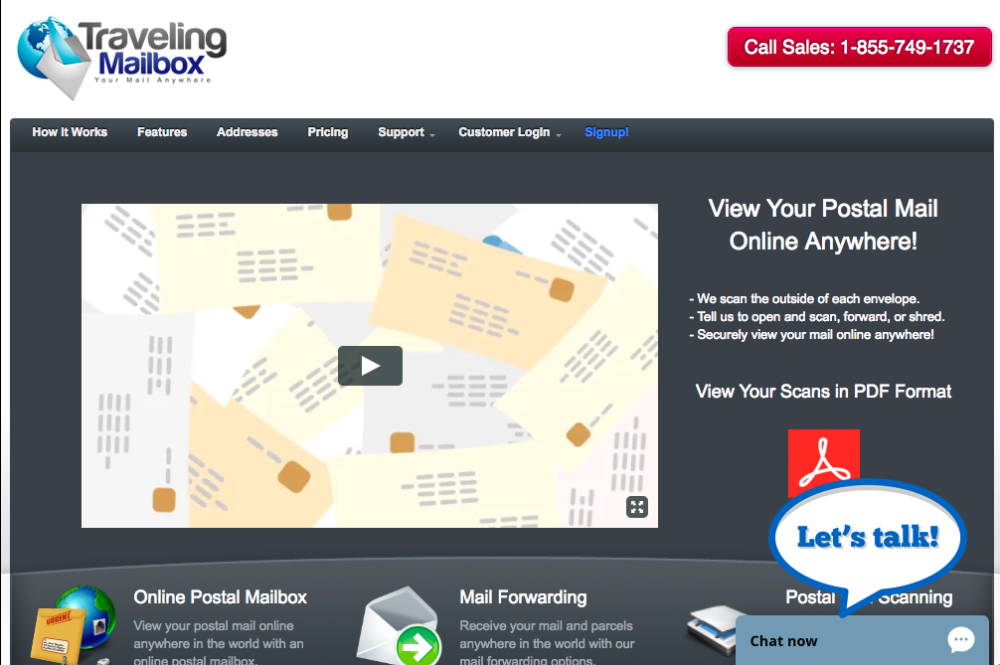
Traveling Mailbox is a highly-rated, US-based virtual mailbox company that has been around since 2011.
The company is a Certified Commercial Mail Receiving Agency with the USPS and their offices are monitored under video surveillance at all times, so your mail should be pretty safe in their hands.
Traveling Mailbox provides all of the standard virtual mailbox services like check deposits, shredding, quick document scanning, parcel forwarding and so on.
Their addresses are exclusively real physical street addresses (no P.O box addresses) so you'll be able to receive packages from courier companies no problem.
Premium addresses are also available to choose from during the sign-up process, although these normally cost a bit extra.
It also has integrations with Evernote, Dropbox, Google Drive and Bill.com, so that you can upload your scanned PDFs to these other apps.
Traveling Mailbox also has its own apps for Android and iOS, so you can manage all your mail from your mobile device.
A neat feature of Traveling Mailbox is the ability to use keywords to tag your mail so that it’s easier to search for and retrieve later. You can also use a folder system to keep your mail well organized.
What's also cool is that you get a toll-free fax number if you're on the extended or small business plan, and incoming faxes will be uploaded to your online mailbox account (they count as page scans). You can also send faxes from your online account for free.
The company offers three plans - a basic plan (cheapest), an extended plan and a small business plan (priciest).
The basic plan allows for 3 mailbox recipients, 40 incoming envelopes and 36 page scans per month.
If you receive more postal mail than that you could try the extended plan, which allows for 5 mailbox recipients, up to 100 incoming envelopes and 80 page scans a month.
The more costly business plan allows for 10 mailbox recipients, 200 incoming envelopes and 180 page scans a month.
All plans include free shredding and unlimited cloud storage for all your digitized mail. You also get 60 days of free physical storage and after that there's a charge of $1 per envelope per month.
2. Anytime Mailbox
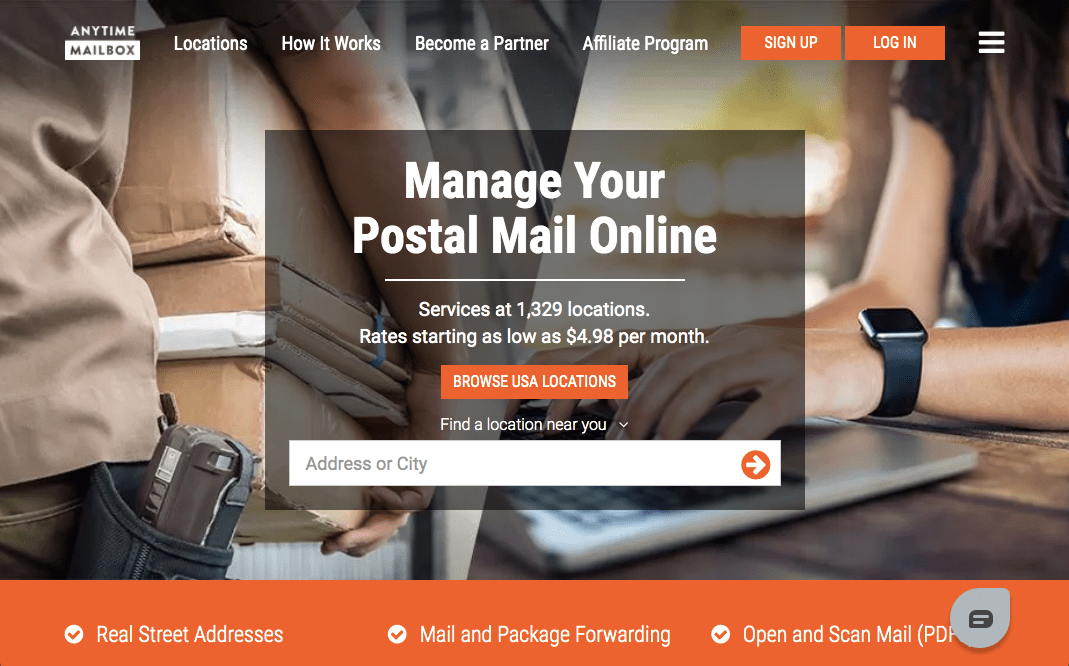
With offices already established in the USA, Philippines and Singapore, Anytime Mailbox is a relatively new but fast-growing provider in the virtual mail industry, offering a digital mailbox service that caters equally to both personal and business users.
Anytime Mailbox takes your privacy seriously, only allowing your mail to be viewed through their secured web portal, where all the images that you view are encrypted using a 2048-bit SSL connection. The company's privately owned servers are kept in a tightly monitored third-party data centre with over 20 years of experience in cloud-based storage.
You can currently choose from over 1,000 real street addresses in the USA and internationally, and the company is aggressively expanding to new cities all the time. While the majority of the street addresses are located in the USA, there are also a reasonable number of addresses available to rent in Europe, Asia, Australia, Canada, Mexico and the Middle East.
When the virtual mailbox you've rented receives your snail mail (letter or package), you'll be notified via text message, email or app notification.
You'll then access the web portal on your mobile device (the app is available for both Android and iOS) or computer, where you can view the scanned letter or package you've been sent. If you wish, you can then request to have the mail physically forwarded to your location, wherever that may be in the world.
Your mail will be stored for as long as you need it; you get free storage for 30 days and after that there's a physical storage charge of $0.05 per mail item per day. When you discard mail, it will be recycled by default, although for items that contain sensitive information, you can opt to have them shredded.
The monthly rental price depends on your digital mailbox location, the plan you choose and whether you exceed the allowances of your plan. Plan options vary by location and some locations only offer one plan. You'll encounter plans with names like "standard", "professional", "bronze", "silver", "gold" and "unlimited" for most locations.
The plans can differ in terms of the maximum number of recipients your mailbox can receive mail for, the maximum number of incoming mail items and the maximum number of scans that you're entitled to each month without incurring additional charges. In many locations, plans start from as low as $9.99 a month.
3. Earth Class Mail
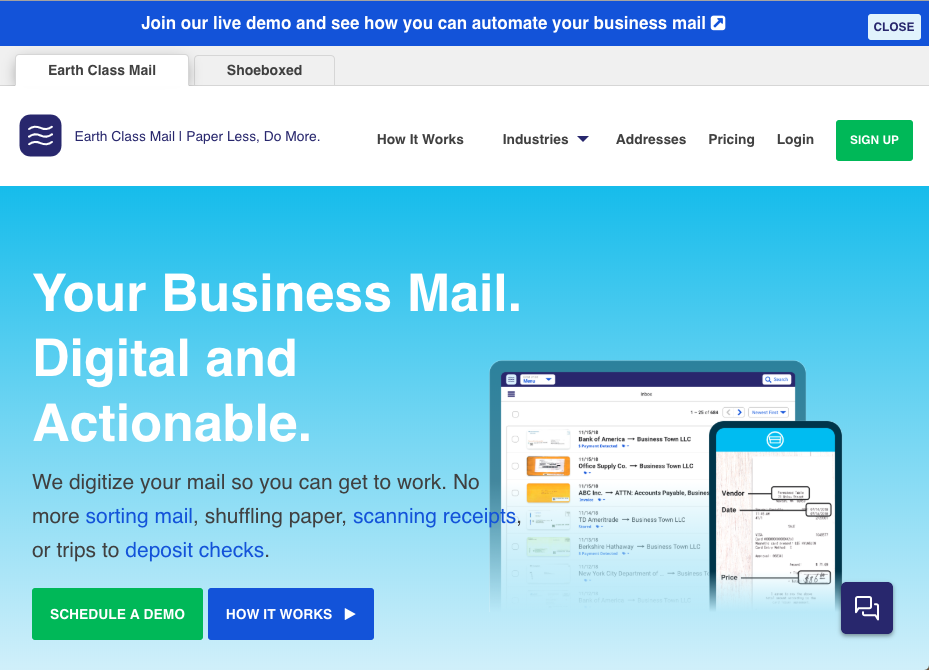
Earth Class Mail is another U.S–based virtual mailbox provider that was founded back in 2004, so they’ve been around a bit longer than Traveling Mailbox.
The company has a reputation for providing top-notch service, although it is one of the pricier providers in the industry.
Earth Class Mail’s primary target market seems to be small businesses and you can see this reflected in how seriously they take security ( 256- bit encrypted cloud storage , “secure shredding” etc.).
It's also evident in the higher volumes of incoming mail they allow for in their plans, and in some of the extra features they provide – features that might not be of much use if you’re not trying to run a business while travelling.
Earth Class Mail has integrations with platforms like QuickBooks Online, Xero, Bill.com, Box and Google Drive to help you complete invoices and save documents to other apps.
The company gives you a much greater selection of addresses to choose from than most other providers that we’ve investigated, and most of these are physical street addresses (a few are P.O boxes).
You can pick an address from 60+ cities across the United States and you can also hold multiple addresses, which isn't possible with many other providers.
One neat feature of Earth Class Mail is the ability to automate your mail workflow with Mailbox Rules, which lets you assign rules for automatically scanning, forwarding, recycling, shredding, depositing checks and syncing mail to cloud storage.
The company offers three plans – virtual address (cheapest), mail automation and mail & check automation (priciest).
The virtual address plan is most suitable for personal or small business use. It allows for 1 mail recipient and 15 mail items, 15 exterior envelope scans and 10 interior mail scans (with up to 20 pages per scan) per month.
The mail automation plan allows for 3 mail recipients, unlimited incoming mail items, unlimited exterior envelope scans and 50 interior envelope scans per month. Check deposits are not included with this plan and cost $10 extra per check.
The most expensive plan, mail and check automation, throws in unlimited recipients, a premium address (instead of standard) and 30 check deposits per month.
With any Earth Class Mail subscription you get 30 days of free physical storage for your mail and 10 days of free physical storage for your packages.
After the free storage period expires, daily fees are imposed, but you can avoid these by forwarding the mail or having it shredded before the day of expiry. Cloud storage for scanned PDF copies of your mail is unlimited with all plans.
4. UK Post Box
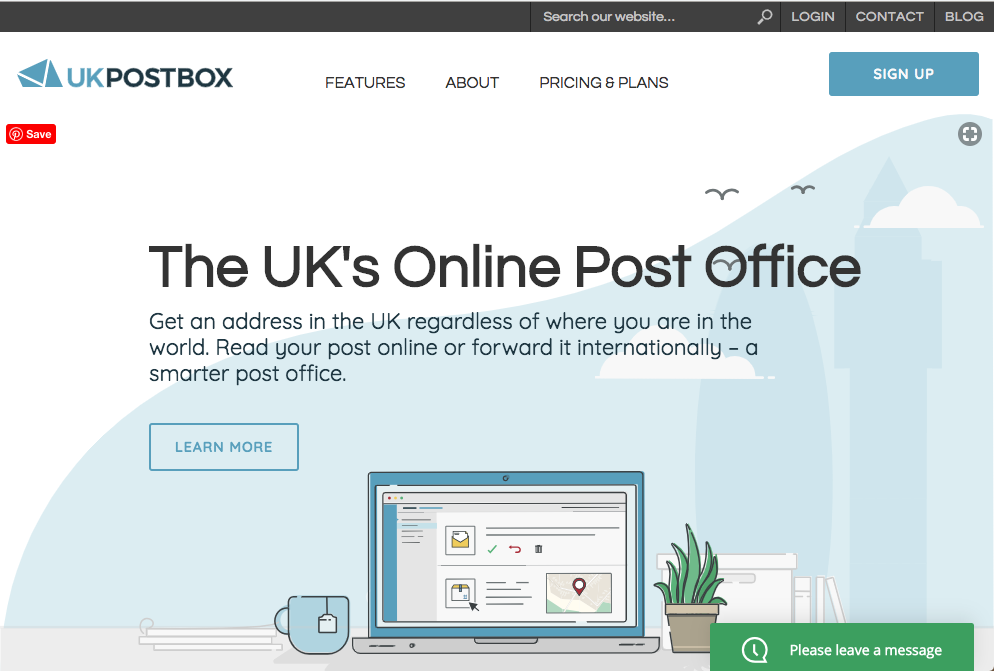
The previously mentioned virtual mailbox providers are all US-based but if you’re a UK traveller or just a traveller that needs a UK address then listen up, because this just might be the answer for you.
UK Post Box is a UK-based virtual mailbox provider that was launched back in October 2008 and has since become the leading online post office in the UK.
The company operates out of a single secure UK sorting facility and is subject to the general data protection regulation, which means that they are obliged to protect all of your information.
UK Post Box can offer you two types of UK address – a free Royal Mail P.O box address and a prestigious, professional-looking London street address (a P.O box address doesn’t look very professional).
Free P.O box addresses are available in 7 major cities (London, Manchester, Glasgow, Birmingham, Cardiff, Belfast, Poole) across the U.K and you only pay for the mail that you receive, whereas there’s a monthly rental charge for a fancy London address.
Even though you can’t normally receive packages to a P.O box address in the U.K, the company solves this problem by giving you a dedicated “courier point address” to have your packages and parcels delivered to.
UK Post Box has most of the standard features you’d expect from a virtual mailbox provider like document scanning, package forwarding, cheque deposits, Dropbox and Evernote integration, mobile and desktop compatibility, 256-bit encryption and 2-step security, 30 days of free physical mail and parcel storage and so on.
But the company’s really unique and standout feature is that it lets you actually post mail (not just forward incoming mail). You can write a letter, upload it to your account and they’ll print out the letter and physically send it to the desired recipient.
UK Post Box offers just two plans – personal & business and shop & ship & e-retailer. You can also contact them for a bespoke plan if you can’t find what you’re looking for.
With the personal & business plan, once you’ve chosen a virtual address from the many options you can choose from five different letter plans, including a pay-as-you-go plan that charges £1.20 per letter received and the same per page scan.
The other four letter plans charge a monthly fee and all include unlimited letters. The plans range from £12 a month for 25 page scans to £336 a month for 1,000 page scans.
You can exceed the page scan limit for your plan but you have to pay an extra fee for each scan after that. All letter plans also allow you to receive PAYG (pay-as-you-go) parcels for £6.00 per parcel.
The shop & ship & e-retailer plan is all about parcels and gives you a free UK parcel address. Again there are 5 plans, with a pay-as-you-go plan where you pay £6.00 for each parcel received.
The other four plans all come with monthly fees and range in price from £42 a month for 10 parcels to £600 a month for 500 parcels. Again you can go over the parcel limit but you’ll pay an extra fee for each additional parcel.
5. eSnail.ca
.png)
Based in Vancouver, B.C, eSnail.ca is the principal virtual mailbox provider for Canadians or anybody who wants or needs to have an address in Canada to receive postail mail at.
Fortunately, eSnail.ca gives you a real street address (not a P.O box address) in Vancouver that looks professional and that you can receive both letters and packages at.
One notable aspect of this provider is that it puts a great deal of emphasis on security, privacy and data protection.
Envelopes are opened, scanned and then resealed by carefully vetted employees (they must pass a federal criminal records check to get hired) in a locked environment under constant video surveillance, so that non-employees can’t ever access your mail.
After scanning your physical mail is stored securely on-site for up to 3 months in case you need to have it forwarded to you. After 3 months your mail will be automatically shredded to eliminate the possibility of data theft.
The digital security is also up to par, with all sessions on the eSnail.ca website encrypted from start to end with 256-bit SSL certified encryption.
Mail files that you’re downloading from the site to your computer are password-protected while being transferred and if you’re having files sent straight to your each file is individually encrypted with a password of your choosing.
All your digital data is stored in redundant offline storage media protected by full-disk encryption, which would take gazillions of years for a determined hacker to crack.
eSnail.ca offers an extensive array of plans ranging in price from $20 a month (backpacker plan) to $54.99 a month (business plan), with a different set of plans available for each city (Vancouver, Toronto, Edmonton and Orlando).
The plans mainly differ in terms of price, the number of names you can have on the plan and the number of envelopes they will scan for you each month before charging $1 per extra envelope.
The “backpacker” plan for Vancouver is probably the best plan for most travellers.
At $20 a month ($16.66 a month if you pay the $200 annual price upfront) the backpacker plan is the company’s cheapest plan and is perfect for any traveller who wants or needs to have a Canadian address while abroad but won’t be receiving a whole lot of mail.
On this plan you can have just one name ($1 charge for each extra name) and they’ll scan (full colour) up to 5 envelopes and their contents for you each month, with a $1 charge for every extra envelope and a $0.15 fee for each extra page.
All plans also come with all the other services that you’d expect from any virtual mailbox provider, including:
- automatic mail forwarding to multiple destinations
- forwarding of cheques (free)
- online storage of your mail in searchable PDFs
- unlimited storage for your eLetters on the company’s server
- email updates when mail arrives in your eLetter box
- automatic secure shredding of old mail after 3 months in storage.
Services that cost extra with eSnail.ca include package forwarding ($10 plus shipping), document forwarding ($10 per forward plus postage) and scanning and forwarding of magazines ($10).
So, which virtual mailbox provider should you go with?
If you live in the US and you only need a virtual mailbox service for personal use (as opposed to business use), Traveling Mailbox or Anytime Mailbox would probably make the most sense.
If you live outside the US or you want to have an international virtual mailbox address while residing within the US, or you need a virtual mailbox service for business use, then Anytime Mailbox is probably going to be the right choice for most of you.
If you’re dealing with high volumes of snail mail or a lot of sensitive mail, you’ll want to go with a provider that takes security extra seriously, that supports automation and that’s more feature-rich. In that case, Earth Class Mail would be your best bet here, if you can afford it.
If you need a UK address or you’d just like to try a UK provider, why not give UK Postbox a try? It would also make a lot of sense if you'll need to send physical letters to correspondents during your travels and you’d rather not endure the hassle of navigating a foreign post office to do so.
Note that all of these virtual mailbox companies offer their services to travellers from different countries all over the world. In other words, you don’t have to be from the US to have an account with providers like Earth Class Mail, Anytime Mailbox and Traveling Mailbox, and you don’t have to be from the UK to get an address in the UK with UK Post Box.
Solution 3: Ask a friend or family member to handle your postal mail on your behalf

If you receive a very small quantity of mail every year, a viable solution is to have all of your mail sent to the address of a trusted friend or family member and ask the person to essentially perform the services of a virtual mailbox provider for you.
You can your personal assistant to notify you when you receive mail, to send you photos or scans of the letters and packages via email or Whatsapp (or whatever) and to forward any documents or items to you that you need to physically obtain.
If you have a person that’s willing to do this then you’re lucky, but it would be unfair to ask this of somebody if you receive large quantities of mail. It might be a different story of course if you’re giving the person some financial compensation for their help.
But really, if you receive mountains of physical mail each month it’s probably best to just choose a virtual mailbox provider and swallow the monthly charge.
Solution 4: Hire a housesitter
If you're a homeowner looking to travel for a few weeks or months, hiring a housesitter is an extremely affordable way to have somebody not only look after your home and pets in your absence, but also to collect, manage and forward your mail if needs be.
For more information on how housesitting works, see "receive packages to your housesitting address" further below.
Solution 5: Digitize your entire life
.jpg)
It’s easier said than done, but perhaps the best solution of all is to just digitize the vast majority of your correspondence so that you almost stop receiving paper mail entirely.
It’s not only going to save you money on renting P.O boxes or hiring virtual mailbox companies whenever you take a longer trip, but it’s also going to help to reduce global demand for paper, which should in turn help the environment by saving trees.
The first step you can take is to say goodbye to traditional banks and switch over to mobile-first FinTech banks like N26, Revolut, Monzo, Starling and others.
These banks have done away with all paperwork and handle absolutely everything digitally. Most of them don’t even have physical branches and exist entirely online.
They will never send you bank statements, letters, security codes, activation codes or anything like that in the mail. All communications take place via e-mail, push notifications and SMS. Even setting up a new bank account requires zero paperwork.
To learn more about this new wave of FinTech upstart banks you can start with our article on the best banks for international travel.
In addition to switching banks, you can also try to reduce your postal mail inflow from utility, Internet and phone companies. Go with companies who offer e-bills as an alternative to paper ones and switch to paperless if you haven’t done so already.
Make sure to also contact any other businesses or organizations that are sending you correspondence in paper form and ask them if it’s possible to switch over to e-mail or another form of paperless communication.
If you’re still ordering physical books and magazines in the mail, have a think about switching over to e-books. To manage and read e-books it's best to use an e-reader device and this in-depth guide covers how to choose the right one for your needs.
Once you’ve gone as paperless as possible and paper mail only ever arrives for you once in a blue moon, you might feel less guilty about asking a friend or family member to open, scan and forward the minuscule amount of mail that does arrive for you, since they’ll probably be quite happy to oblige.
How to receive packages when travelling
Packages are a slightly different beast to paper mail, because they have to physically reach you. A digital image or scan of that new backpack you ordered from Amazon won’t hold all your gear unfortunately.
Luckily, the task of receiving a package when you’re travelling isn’t rocket science and in many situations you'll be able to choose from a range of options for where to have the package delivered.
Below we've put together a list of the most effective ways to receive a package when you’re travelling.
It's good to be aware of all these options, just like how it's never a bad thing to have plenty of tools in your toolbox.
Have the package delivered to a parcel locker near you
There now exist several companies around the world that (for a fee) provide secure holding lockers that people and companies can send parcels to, so that the recipient is able to collect the parcel independently at his/her own convenience.
Unfortunately, none of these services have a worldwide network of lockers. Most are confined to specific countries, and some are limited to receiving parcels sent by specific retailers.
Here are a few of the better-known parcel locker services.
Amazon Lockers
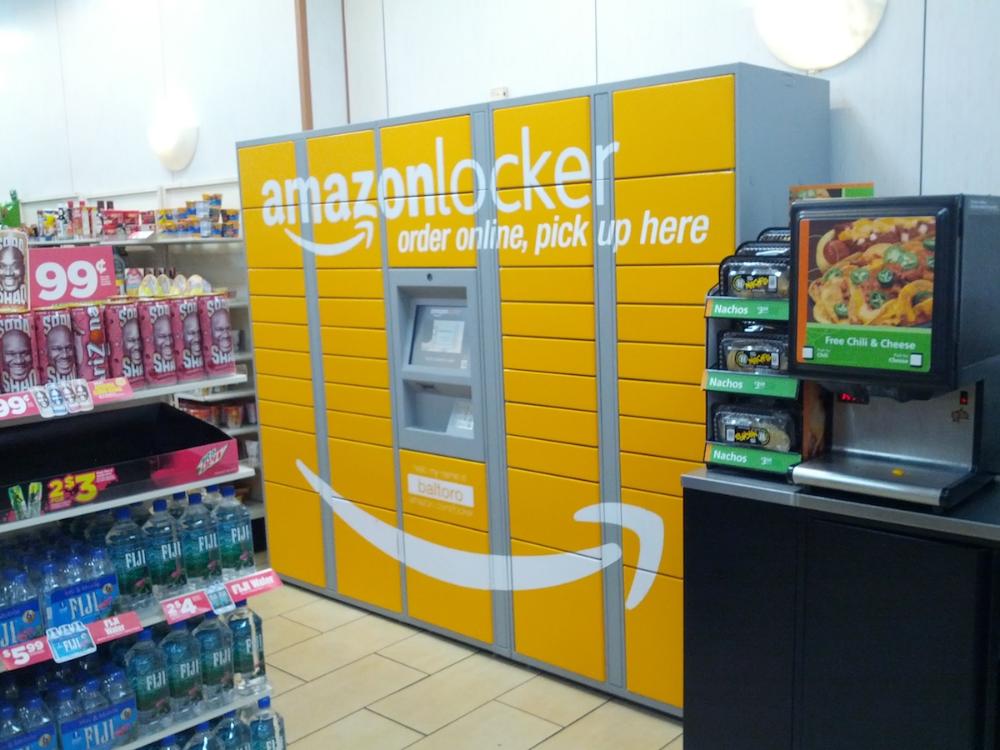
Amazon Lockers allows you to send packages to a secure self-service storage locker for pick-up at your own convenience.
The service was set up to solve the problem of packages being returned to the depot when they would arrive at people’s homes while they were at work or out of the home for whatever other reason.
Presently there are over 2,800 Amazon lockers in 70+ Metropolitan areas across the U.S and more than 2,200 in the U.K, and Amazon plans to expand the service to continental Europe next.
To collect a package from an Amazon locker all you have to do is go to a locker location (often in grocery stores or convenience stores) during the collection hours (these can vary depending on the day of the week).
Once you’ve found the lockers you just need to go up to the terminal, which has a touchscreen for you to key in your unique 6-digit code that Amazon sends you by e-mail after your package arrives.
Once you’ve inputted the correct code, the door of your locker will automatically swing open, revealing your package inside.
Packages are held in the locker for a maximum of three days and if not collected within the timeframe it will be returned and you will be refunded. Most lockers are only accessible during certain pick-up times and these can vary depending on the day of the week.
Note that you can only use Amazon Lockers to hold packages that you bought on Amazon, so if you’re shopping on another website you won’t be able to have the item delivered to an Amazon Locker.
However, it’s also worth mentioning that in some countries that don’t have Amazon Lockers, Amazon has found another solution. In Germany for example, Amazon uses lockers owned by Deutsche Post (DPWGn.DE).
When you’re travelling Amazon Lockers works best with an Amazon Prime Membership, since you get free expedited two-day delivery on all orders.
Standard shipping with Amazon is sometimes just too slow (up to 32 days for some destinations) and unreliable when you’re only spending a couple of days in a particular town or city and you need your package delivered within a narrow timeframe.
Parcel Motel
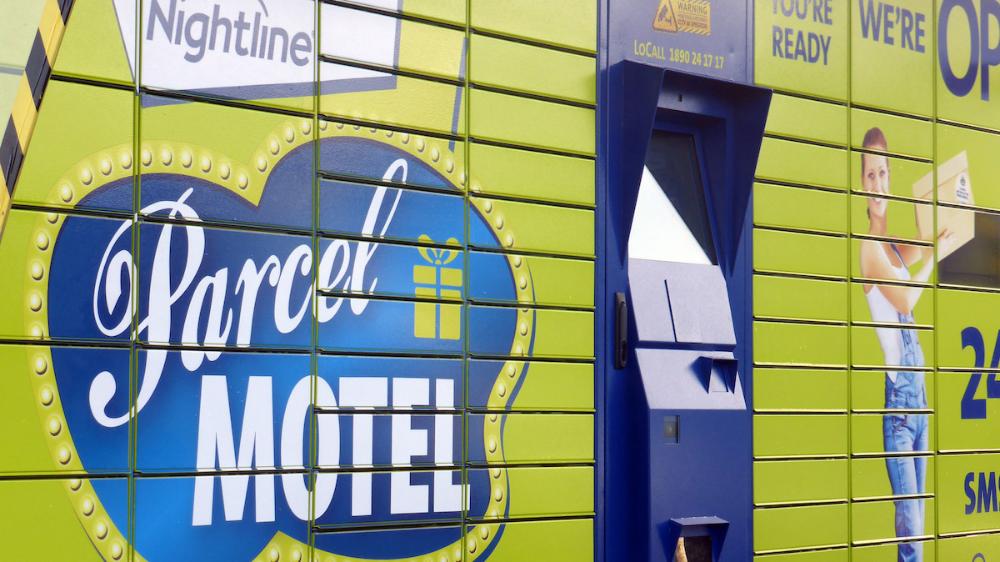
Another similar service to Amazon Lockers that I know of is Parcel Motel, although so far they only have lockers in the Republic of Ireland.
You can use Parcel Motel to receive packages sent from any online retailer, as the service is not tied to any specific seller in the way Amazon Lockers is.
It costs €3.95 to have a parcel held in a locker for the standard 48-hour period, and this charge is additional to any fees you might have to pay to the online retailer for the delivery of your package.
To get a package sent to a Parcel Motel locker, all you have to do is enter your Parcel Motel ID and your preferred Parcel Motel virtual delivery address when asked for delivery details while making an online purchase.
Then when the parcel arrives you’ll receive a text message with a unique PIN code and the collection point location.
Once you reach the location with the lockers, you just have to enter the code along with your mobile phone number to release your package.
The lockers are located in places like petrol stations, train stations and 24/7 convenience stores, so that you can collect your package round the clock whenever best suits.
If you haven’t collected your package after 48 hours it will be returned to the Parcel Motel (Nightline) Depot, but can be sent back out to your collection point for three more 48-hour stays, for a fee of €3.95 per stay.
So if you ever happen to be travelling in Ireland (it’s a beautiful country) and you need to receive a package during your trip, keep Parcel Motel in mind.
Many other countries probably have similar services so just research the specific country you’re travelling in and find out if there exists such a service.
Courier company lockers
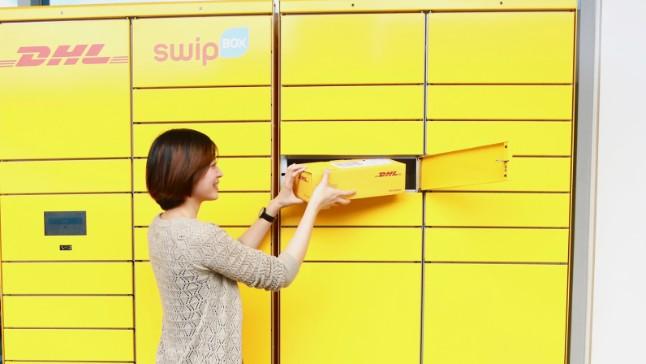
Some courier services now have lockers where you can pick up your parcel independently at your own convenience.
For example, DHL has a network of Service Point Lockers around the world from which you can collect your shipment between certain hours.
These work very much like the other parcel lockers we discussed above, where you receive a unique code via text or e-mail that you need to enter at the touchscreen terminal to release the package from the locker.
UPS has its own Access Point Network for independent package collection. This network includes over 4,400 UPS stores across the U.S as well as independent local businesses like pharmacies, florists and grocery stores that have joined the network. The network also includes Access Point Lockers, which are unstaffed and allow self-service pick-up of parcels.
FedEx also has a network of Ship&GetSelf-Service Lockers where they’ll hold packages for up to 5 days. Unfortunately these are only currently available across Texas and also in Memphis, Tennessee.
Have the package delivered to the post office of the town/city you're visiting
Post offices around the world provide a very useful service known as “general delivery” (or “poste restante” in Europe) for itinerant individuals without a stable address.
When the post office receives a package or letter sent by general delivery they will hold onto it until the recipient arrives to collect it.
In the U.S for example, you can use the general delivery service to get USPS to hold a package for you at a post office for up to 30 days, and here the service is free. In certain other countries there may be a fee imposed.
To send a parcel or letter by general delivery, all the sender has to do is write the address of the target post office on the parcel and then write “GENERAL DELIVERY” at the top of the address on the package (above the recipients name).
The problem with general delivery is that post offices can be big, chaotic places and packages can and do sometimes get lost in them. Sometimes this can happen because the post office employees are not even informed about what a general delivery is.
Another issue is that many post offices are reluctant to hold packages that were delivered by a courier such as DHL or FedEx, even though they’re technically supposed to hold them regardless.
This is really a service that was intended for parcels and letters sent through the regular postal system.
If you are going to send a parcel via general delivery, it’s a good idea to call the post office in advance and just make sure that they do offer this service and they understand what it is.
In spite of the drawbacks, it’s worth keeping general delivery in mind in case you ever do need to use it. Some extra good news is that Amazon will accept general delivery orders.
Have the package delivered to a local courier store or depot
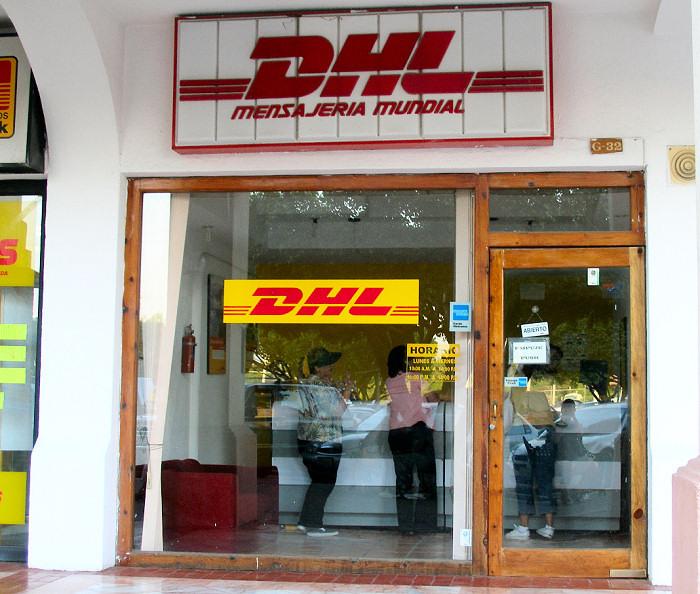
Courier companies like DHL, UPS, and FedEx have stores and depots in many countries around the world and you can often have one of these locations receive and hold onto your package for you until you come and collect it.
This may be a viable alternative if the courier company delivering your package has no self-service parcel lockers where you’re travelling.
Do take note that courier depots (or hubs) and stores are two very different things.
Depots are the main distribution facilities for a particular area where packages are sorted and then sent on to their final destination, whereas stores are those small shops you see on streets or in shopping centres, like in the image above.
Depots shouldn't charge money to receive and hold your package, but they tend to only be open for very few hours in the day (often for only 1-2 hours), and each store has its own specific hours.
Stores will usually charge you up to $15 dollars just to hold your package, and we have heard that store employees will often make up prices on the spot.
If you're planning to collect a package from say, a DHL store or depot, it's imperative that you ensure the package is being delivered by DHL, because if UPS or some other company delivers the package they will probably refuse to accept it.
In any case, once you know what courier company your parcel is being delivered by, you can always get in touch with the company directly and ask if you’d be able to have the package delivered to a local store or hub and if so, how long would they hold it for you.
Have the package delivered to your hotel/guesthouse/hostel etc.

This can be an effective delivery option if you’re going to stay at a particular hostel, guesthouse or hotel for a couple of nights.
It works especially well when you’ve already checked into the property and you’ve decided that the staff is competent and trustworthy enough not to lose your package.
This is exactly how I received a replacement debit card (my bank account got hacked in Sri Lanka) that my kind parents mailed me from Ireland when I was staying at a budget hotel in the city of Bandung in Java, Indonesia.
I notified the owner of my hotel (fortunately he could speak English quite well) that a package would soon arrive in the mail for me, and then I kept myself busy exploring the surrounding sights and attractions for the next 10+ days (it was sent by snail mail) until the package was finally delivered.
One day a member of staff knocked on the door of my room and informed me that the package had arrived and lo and behold, I had received my new debit card that had travelled over 12,000 km from Ireland to Indonesia by snail mail.
If you’ve booked a stay somewhere but haven’t yet checked in at the property, it could be a bit of a gamble to send a package there in advance of your arrival, as you won’t really know whether you can trust the staff with your package until you get there.
If you are sending a package to a property in advance of your own arrival you should definitely call ahead to notify the manager when you expect the package to arrive.
Do be aware that some hotels have started charging guests to receive packages (often around $15 per item in the U.S) but if you're a budget traveller and you stick to simpler, more affordable accommodation I'd wager that you'd be pretty unlikely to ever run into these fees.
Have the package delivered to your local host's property

If you’re ever using hospitality exchange platforms such as Couchsurfing, BeWelcome or HospitalityClub to find accommodation in a country, you can try asking your upcoming host if they wouldn’t mind receiving and holding a package for you.
Since it can often be hard to find a host that’ll let you stay longer than 4-5 nights using these hospitality platforms, it’s probably best to have the package sent to your host’s address in advance of your arrival.
You don’t want to be stuck in a situation where you’ve overstayed your welcome and the host is anxious for you to leave, and you also want to leave, but you can’t leave because you’re still waiting on your package to be delivered.
If the package precedes you it should be in safe hands but just make sure that your host is an active user of the platform with plenty of positive reviews, very few if any negative reviews, and that the profile doesn’t look sketchy.
If you’re really uncertain about your host you could try to arrange a phone call or video call just to suss him/her out a bit better.
But the great thing about Couchsurfing hosts is that many of them have done some travelling themselves, so they've probably experienced the struggle of receiving a package when travelling for themselves, and will be better able to empathize with your situation.
Another occasion that you can ask a local host to receive and hold a package for you is when you’ve booked an Airbnb or some other local rental.
Again, you should contact your host before sending the package to make sure that he/she is available and willing to take custody of your package, as there’s every chance that your request will be refused.
Have the package delivered to your housesitting address

If you’re ever doing a house-sit during your travels, not only will you have an address to receive packages at, but you won’t have to entrust the goods to anyone else – they will be delivered directly to you.
In case the concept of housesitting is unfamiliar, it’s where you temporarily assume responsibility for a homeowner’s property and pets while they’re away.
In exchange for your services you get a free place to live without having to pay any rent (and often no utilities either), though you will usually have to cover certain personal expenses like food and transport.
Since housesits are usually more long-term arrangements lasting anywhere from a week to several months, you will normally have plenty of time to receive a package before the homeowner returns and it’s time for you to leave.
To learn more about how housesitting works, read our Ultimate Guide To Housesitting For Beginners.
Have the package sent to a friend or relative's home

If you’re lucky enough to be travelling to a town or city where you have friends or relatives living, you can just hit them up and ask them if they wouldn’t mind receiving and holding a package for you until you get there.
This one’s a lot easier than many of the other options since you probably trust friends and family a lot more than say, a stranger with a Couchsurfing profile that has agreed to host you.
Unfortunately, when it comes to family members you only have so many of them, and it’s highly unlikely that you’re going to be travelling in the area that they’re residing when you need to receive a package.
But the number of friends (or shall we saw, acquaintances) you can acquire is virtually unlimited, and it’s possible to grow an extensive network of contacts from different countries all around the world, even if you’re not travelling.
By building a large social network, you can greatly increase your chances of having a dependable person to receive and temporarily hold a package for you when you’re travelling.
To build such a global network of allies it will take time and you’ll have to get really social whenever you’re travelling. Talk to people and try to befriend strangers at every chance you get, not just with fellow travellers but with locals too.
One of the best ways to meet new people (from all around the world) on the road is to frequently stay in hostels and socialize with the other guests as much as possible.
Platforms like Couchsurfing are also great for making new connections with locals and travellers wherever you go. Check out this article for a list of traveller-oriented online social networks that help you connect with both travellers and locals while on the road.
Facebook groups are also really useful for connecting with like-minded people abroad and there are often groups for specific cities too, where you can publicly request if somebody wouldn’t mind receiving and holding a package for you until you arrive to collect it.
Even if you never get a chance to travel you can still use platforms like Couchsurfing to host other travellers from around the world and make valuable connections that will serve you well when you go abroad again in the future.
Just make sure that whenever you make a new international friend you remember to get their contact info or social media handles so that you can stay in touch. Pretty much everyone is on Facebook these days.
Conclusion
Managing one's physical mail remotely and receiving packages while on the move were more challenging problems to solve in the past, but not so much anymore.
The first problem has been largely solved with the appearance of virtual mailbox providers in the last two decades, providing a very convenient and comprehensive mail management solution for travellers.
Major headway has also been made on addressing the second problem; with today’s ever-expanding networks of courier company stores, local pick-up points and self-service lockers, it’s now easier than ever to receive packages on the road.
Perhaps in the future the world will go entirely paperless, which will liberate travellers from having to manage physical mail entirely.
But it’s likely that even if that happens, travellers will still need to have a physical address to fully participate in the modern world – for things like voting, taxation, vehicle registration, insurance, banking and so on.
One thing we can count on is that there’ll always be the issue of receiving those troublesome packages.
If you enjoyed this article or found it helpful, please share it with other travellers. And now we'd like to hear from you. What is your system for managing your postal mail when you travel? Do you have any tips you'd like to share? Leave us a comment below and we'll get back to you as soon as we can.
JOIN OUR LIST
SUPPORT US
FOLLOW US
ABOUT US
Our names are Eoghan and Jili and we hail from Ireland and India respectively.
We are two ardent shoestring budget adventure travellers and have been travelling throughout Asia continuously for the past few years.
Having accrued such a wealth of stories and knowledge from our extraordinary and transformative journey, our mission is now to share everything we've experienced and all of the lessons we've learned with our readers.
Do make sure to subscribe above in order to receive our free e-mail updates and exclusive travel tips & hints. If you would like to learn more about our story, philosophy and mission, please visit our about page.
Never stop travelling!
FOLLOW US ON FACEBOOK
FOLLOW US ON PINTEREST
-lw-scaled.png.png)


